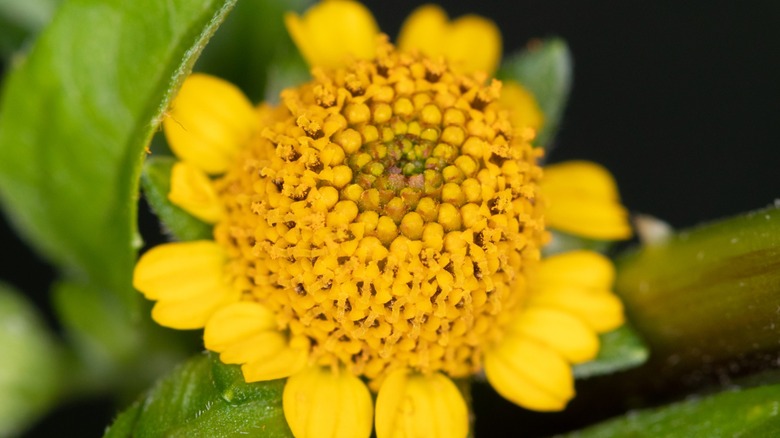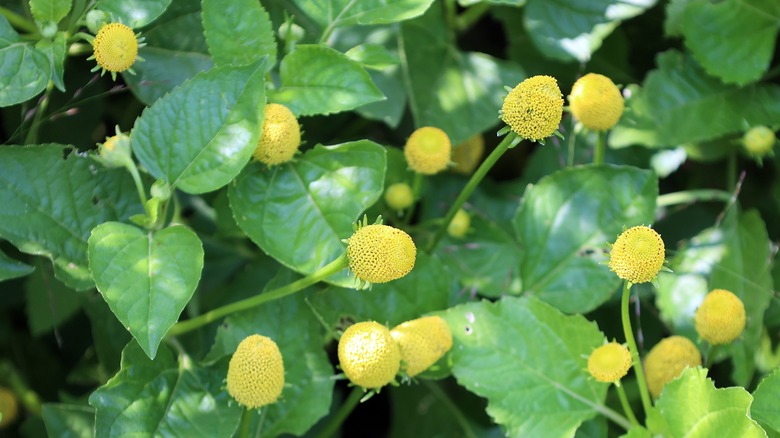The Little-Known Plant That Changes Your Sense Of Taste Like Magic
You're undoubtedly familiar with the tradition of serving small snacks between different dishes during a meal, which allows you to reset your tongue's taste buds before the next course commences, but it isn't common for the palate cleanser to make the meal. Nevertheless, some of these tastebud refreshers are flavorful enough to be the star of the show. One of these standout palate cleansers is the Szechuan button, a small yellow flower that is sure to shock, literally.
In fact, this peculiar plant has transcended the palate-cleaning phase and has become a proper ingredient. Its tingly taste comes from spilanthol, an alkaloid that triggers our tongue's saliva centers. Some describe the sensation as being akin to licking a live battery. When you take this fascinating fact into account, it's easy to understand why the Szechuan button appears in both food and drink — and also why the flower goes by the alternative titles of "buzz button" and "electric daisy."
The science of Szechuan buttons
When starting to study the buzz button, you must understand the popularity of a similar but unrelated plant, the Szechuan pepper. You can use Szechuan peppercorns for aromatic chili and many other delicious dishes. The peppercorns contain the chemical hydroxy-alpha-sanshool. Spilanthol, found in the electric daisy, is a different molecule, though it does have a similar stimulating effect. Szechuan buttons may seem spicy, but without capsaicin, these little flowers can't actually burn.
Rather, the bud's spilanthol content causes your lips and mouth to lose some sensation and tingle as your nerves are triggered by this numbing molecule. A 2013 study published in Proceedings of the Royal Society B that had participants press a tool to their lips after eating Szechuan peppercorns and attempt to match the frequency of vibration they felt suggests that this movement registers at around 50 Hertz.
Spicy foods are traditionally associated with uncomfortable sensations, like burning, but the buzz button is also called the toothache plant, a reference to one of its original medicinal uses: The painful nagging of a troublesome tooth could be counteracted by the flower's numbing properties before the advent of painkillers.
Tasting the toothache plant
The Szechuan button has been enjoyed around the world for quite some time. Brazilian cooks have used it in a variety of foods, as is the case in India, where you can also buy chewing tobacco infused with electric daisies for a little extra buzz. But you couldn't find buzz buttons being sold in the United States until the 2000s. Chef Ferran Adrià, founder of the famous restaurant elBulli — which chef José Andrés feels changed "culinary mankind" – was one noteworthy cook who tried using Szechuan buttons in a dish early on.
He made a cookie crisp out of dehydrated milk, then placed a bright yellow buzz button on top of this white wafer. In this dish, and other food and drinks featuring the flower, it serves as both a flavor enhancer and a decorative garnish. The flower is also featured at Union, an Italian eatery in Pasadena, California. There, the buzz button gives bowls of beet cappelletti a spicy and flowery flavor profile.
And at The Cosmopolitan Hotel's Chandelier Bar, a single buzz button appears atop the gin-based Verbena cocktail. Mixologists insist that those who order the cocktail hold off on sipping, and chew the bud for a little while first. If you want to try tasting a toothache plant for yourself, you should be sparing to start — a small sprinkling of flowers will likely suffice. This way, you won't make a mouthwatering meal or delicious drink that makes you feel like you just got out of the dentist's chair.


